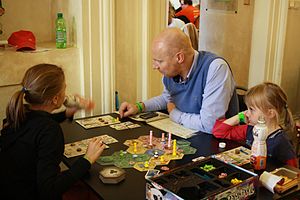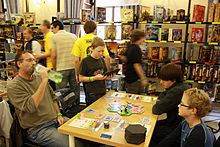Takenoko
| Takenoko | |
|---|---|

|
|
| Game data | |
| author | Antoine Bauza |
| graphic |
Nicolas Fructus , Joël Van Aerde, Yuio, Julien Jeanroy-Bertrand |
| publishing company |
Bombyx / Matagot , Asmodee , Pegasus Games (since 2014) |
| Publishing year | 2011 |
| Art | Board game |
| Teammates | 2-4 |
| Duration | about 45 minutes |
| Age | from 8 years
|
| Awards | |
|
As d'Or - Jeu de l'Année 2012 |
|
Takenoko is a board game by the French game designer Antoine Bauza , published in 2011 by Matagot . In 2012 it won the French game award “ As d'Or - Jeu de l'Année ” and was recognized as a “game hit for families” at the Austrian game award “ Game of Games ”.
Game idea and process
Takenoko (Japanese: "bamboo shoot") is set a long time ago at the court of the Emperor of Japan. The Chinese emperor gave him a holy panda as a symbol of peace. His courtiers, the players, now have to take care of the panda and at the same time try to grow bamboo in the fields of the courtyard garden . For this, the players receive hidden tasks, the completion of which earns them victory points . The aim is to collect the most victory points by the end of the game.
The game material includes:
- 28 hexagonal beds (1 garden pond, 9 each green, yellow, pink)
- 90 interlocking bamboo pieces in green, yellow, pink
- 20 blue irrigation channels
- 9 improvement tokens
- 46 task cards in three categories ("bed", "gardener", "panda")
- 4 player boards
- 8 action pieces
- 1 hand-painted panda figure and 1 gardener figure each
- 1 weather cube
At the beginning the bamboo garden only consists of the garden pond; the panda and the gardener also start there. The beds and task cards are shuffled and laid out as a face-down pile along with the rest of the game material. In addition to his game board and two action pieces, each player also receives three task cards. These are divided into three categories and each indicate certain conditions that must be met. This can be, for example, a certain arrangement of beds in the garden ("bed" tasks) or the presence of certain pieces of bamboo in the player's supply ("panda" tasks).
The game is played in turn. When it is a player's turn, he first checks the weather conditions with the weather cube. The weather rolled influences the next move and can, for example, enable an additional action or the construction of an improvement. Then the player performs two of a total of five possible actions:
- Create a new bed in the bamboo garden
- take an irrigation channel from the supply and, if necessary, immediately lay it out between two beds (bamboo can only grow on watered beds)
- move the gardener to another field to grow bamboo on this and adjacent fields
- move the panda to another space in order to let it eat bamboo there (the piece of bamboo goes into the player's supply)
- draw a new task card
Certain weather conditions allow the player to equip a bed with one of three improvements: a fence protects the bed from the panda, garden maintenance accelerates the growth in the field and a water tank supplies the corresponding field with water even without an irrigation channel. An improvement is already printed on some beds and cannot be improved any further.
If a player can fulfill the conditions of one or more of his task cards in the course of his turn, he lays down the corresponding cards face up; they now bring him the number of victory points printed on them. If a player has been able to complete a number of tasks depending on the number of players, he receives bonus points in the form of the emperor's card , after which each player can make one last move. The winner is whoever has accumulated the most victory points by the end of the game.
Awards
In 2012, Takenoko won the French critic's award “ As d'Or - Jeu de l'Année ” and received the award “Game hit for families” from the Austrian game award “ Game of Games ”. In the same year it was also nominated for the Dutch Games Award.
Collector's Edition
In August 2013, Matagot released the version with large game material, which was previously only used for demonstrations, as a Collector's Edition in a wooden box. The pieces of bamboo, beds and figures it contains are about three to four times as large as in the original edition. This edition was also presented at the " Spiel 2013 " trade fair.
Web links
- Takenoko in the Luding games database
- Takenoko in the game database BoardGameGeek (English)
- Information and rules of the game (PDF) at Pegasus Spiele
- Game description at Matagot (French)
